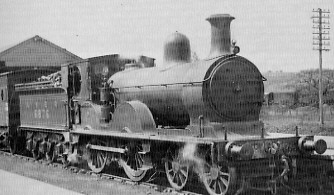The Manson D38 (GNSR Class Q) 4-4-0 Locomotives

Manson's Class O (LNER D42) express locomotives of 1888 were proving successful, so it was natural that when the Great North of Scotland Railway (GNSR) required further express locomotives in August 1889, that the same basic design would be used. The new locomotives were fitted with a new, larger eight wheel tender. Six locomotives were ordered and all were delivered in 1890. Three kept the D42's 6ft 0.5in driving wheels and became GNSR Class P (LNER D43). The remaining three had larger 6ft 6.5in driving wheels and became GNSR Class Q (LNER D38). The D38s were Manson's last locomotives for the GNSR, and were actually delivered after his resignation in August 1890.
The new eight wheel tenders fitted to the D38s were fitted with a leading bogie and two rigid rear axles. At the time, these were the largest tenders in use on the GNSR and were designed specifically for through workings between Aberdeen and Elgin. Their 4 ton coal capacity was exceeded by some later GNSR tenders, but their 3000 gallon water capacity was never exceeded. Nos. 75 & 77 had later Johnson-designed six wheel tenders fitted before Grouping (1923). The LNER fitted a similar tender to No. 76 shortly after Grouping. All of the eight wheel tenders were scrapped.
The GNSR "rebuilt" (ie. reboilered) all three locomotives. No. 77 was fitted with a superheated boiler with a Schmidt superheater in August 1912. A superheated boiler was also fitted to No. 75 in July 1917, although the superheater was of the Robinson type. No. 76 received a replacement saturated boiler in May 1914. All three new boilers were of the same size and proportions as the original boiler design. All were interchangeable with the boilers used on the D42 and D43 classes; and very similar to the boilers used on the D40, D41, and G10 0-4-4T classes. The LNER fitted new boilers to Nos. 75 & 76 (LNER Nos. 6875 & 6876), but No. 77 (LNER Nos. 6877) retained its Schmidt boiler until withdrawal. No. 76 remained saturated until withdrawal.
The boilers were fitted with Ramsbottom safety valves. These were initially mounted with their tall columns and spring exposed, but they were enclosed with neat casings when the new boilers were fitted. Ross pop safety valves were later fitted by the LNER.
The GNSR usually allocated the D38s to Kittybrewster. Initially they were used on express trains between Aberdeen and Elgin - a duty for which their large tenders were specifically designed for. They were also used to haul passenger traffic on the Buchan line.
Immediately after Grouping (1923), No. 6875 continued to be allocated to Kittybrewster and worked the Deeside line. No. 6876 was allocated to Keith, and No. 6877 to Elgin. Both hauled regular main line passenger services to Aberdeen, and eventually returned to Kittybrewster. As the only saturated D38, No. 6876 was also the first to be withdrawn (February 1931). The remaining two D38s were often used on the passenger service between Banchory and Ballater. No. 6875 acquired a particularly good reputation with the enginemen during this period, and was a favourite for excursion traffic. The last two D38s were withdrawn in September 1937 (No. 6877) and January 1938 (No. 6875).
Technical Details
| Saturated | Superheated | ||
| Cylinders (x2): | (inside) | 18x26in. | 18x26in. |
| Motion: | Stephenson | Stephenson | |
| Valves: | slide | slide | |
| Boiler: | Max. Diameter: | 4ft 6in | 4ft 6in |
| Boiler: | Pressure: | 165psi | 160psi |
| Diagram No.: | 88 | 88 | |
| Heating Surface: | Total: | 1165 sq.ft. | 1000 sq.ft. |
| Firebox: | 106 sq.ft. | 106 sq.ft. | |
| Superheater: | 140 sq.ft. (18x1.1in) | ||
| Tubes: | 1059 sq.ft. (213x 1.75in) | 512 sq.ft. (104x 1.75in) | |
| Flues: | 242 sq.ft. (18x 4.75in) | ||
| Grate Area: | 18.2 sq.ft. | 18.2 sq.ft. | |
| Wheels: | Leading: | 3ft 9.5in | 3ft 9.5in |
| Coupled: | 6ft 6.5in | 6ft 6.5in | |
| Tender: | 4ft 1in | 4ft 1in | |
| Tractive Effort: | (@ 85% boiler pressure) | 15,050 lb | 14,594 lb |
| Wheelbase: | Total: | 43ft 3in | 43ft 3in |
| Engine: | 21ft 8in | 21ft 8in | |
| Tender: | 13ft 0in | 13ft 0in | |
| Weight (full): | Total: | 83 tons 8cwt | 84 tons 8cwt |
| Engine: | 46 tons 0cwt | 47 tons 0cwt | |
| Tender: | 37 tons 8cwt | 37 tons 8cwt | |
| Adhesive Weight: | 31 tons 15cwt | 32 tons 5cwt | |
| Max. Axle Load: | 16 tons 10cwt | 16 tons 13cwt |
Preservation
The last D38 was withdrawn in 1938, and none have survived into preservation.
Models
I am not aware of any models of the D38 in any scale.